From inside Space Shuttle Discovery, astronauts watched Joe Allen inch toward Palapa B2, an Indonesian communications satellite stranded in low-Earth orbit by a failed kick motor. Allen stabbed the Stinger, a device NASA engineers created for this purpose, into the satellite’s engine nozzle.
“With his cargo on a stick, Joe, the smallest male astronaut in the corps at five feet six inches, looked like the world’s strongest man grabbing hold of the 1,200-pound Palapa, as he slowly swung that satellite around, putting himself and his prize in just the right position for Anna,” Bloomberg News reporter Loren Grush writes in “The Six: The Untold Story of America’s First Women Astronauts.”
Anna Fisher, an emergency room physician and one America’s first women astronauts, deftly maneuvered the Space Shuttle’s robotic arm to move Palapa B2 and Allen into the payload bay.
Space history buffs may know that bringing Palapa B2 back to Earth posed further challenges, since the clamp to move the satellite inside the Shuttle was too small. Plus, during the same November 1984 Shuttle flight, astronauts had to repeat the complex procedure to retrieve the Westar 6 communications satellite.
Whether or not you’re versed in Shuttle history, “The Six” is a compelling account of the extraordinary women in NASA’s 1978 astronaut class, the first to include anyone other than white males. Particularly remarkable are first-hand accounts of arduous survival training, and the often chauvinistic public and media attention the women received.

Do you weep?
A concerned citizen told Fisher, the first mother in space, “just how irresponsible she was being” for leaving her child. “It didn’t matter that plenty of fathers had been to space before,” Grush points out.
Surgeon and pilot Rae Seddon was described in Weight Watchers magazine as looking “like a college cheerleader — and one of the nicest and prettiest girls on sorority row.”
A reporter asked astrophysicist Sally Ride, the first American woman in space and a competitive tennis player, if she wept when faced with a problem during training exercises.
“Sally’s face screamed what she couldn’t say out loud herself: You cannot be serious,” Grush writes. “Trying her best to remain as collected as possible, she laughed, shook her head, and gave the best response she could think of: “Why doesn’t anyone ask Rick those same questions?”
Ride’s reference to Frederick “Rick” Hauck, STS-7 pilot, engineer and retired U.S. Navy captain, drew a laugh from the crowd. Ride then offered a more serious reply. “I don’t think I react any different than anybody else on the crew does.”
Doctor, Engineer, Pilot, Astronaut
Grush paints vivid portraits of each woman, from their childhood fascination with science and space to their achievements before, during and after becoming astronauts.
Shannon Lucid, a chemist and pilot who had three children when she joined NASA, flew on five Shuttle missions and spent six months aboard Russia’s Mir space station.
Judy Resnik, an electrical engineer, pilot, classical pianist and the first Jewish-American astronaut, died in 1986 when the Space Shuttle Challenger exploded soon after liftoff.
Kathy Sullivan, a geologist, oceanographer and U.S. Naval Reserve officer, explored the depths of the world’s oceans and was the first American woman to conduct a spacewalk.
Grush, the daughter of two NASA engineers, has reported on space and science for more than a decade. Her book details the myriad challenges the women faced, from ill-fitting spacesuits to scrutiny of their private lives. “The Six” is also a tale of perseverance.
“The Six understood that as the first women, their every move was being scrutinized, more so than the performance of any of their male colleagues,” Grush writes. “They also realized that if one of them messed up, critics would pounce, using the failure as evidence that women weren’t fit for space.”
Laugher and tears
Humor and pranks popular among certain spaceflight crews enliven the book, which also contains a heart-wrenching account of the Challenger tragedy.
When Resnik’s colleagues learned what happened, “grief gripped their hearts and uncertainty hung heavy in the air,” Grush writes. “The scale of it was unimaginable for everyone. They hadn’t just lost one friend. Seven people were gone in an instant,” colleagues, friends “and one of the Six.”
“The Six” offers the historical context for female astronauts including Soviet cosmonauts Valentina Tereshkova, the first woman in space in 1963, and Svetlana Savitskaya, who became the first woman to exit her space vehicle less than three months before Sullivan’s first spacewalk.
As for Fischer claiming the title of first mother in space, “apparently, the Soviet Union did not have among its female cosmonauts a woman they could send up to steal that title,” Grush writes.
- SEO Powered Content & PR Distribution. Get Amplified Today.
- PlatoData.Network Vertical Generative Ai. Empower Yourself. Access Here.
- PlatoAiStream. Web3 Intelligence. Knowledge Amplified. Access Here.
- PlatoESG. Automotive / EVs, Carbon, CleanTech, Energy, Environment, Solar, Waste Management. Access Here.
- PlatoHealth. Biotech and Clinical Trials Intelligence. Access Here.
- ChartPrime. Elevate your Trading Game with ChartPrime. Access Here.
- BlockOffsets. Modernizing Environmental Offset Ownership. Access Here.
- Source: https://spacenews.com/breaking-the-celestial-ceiling/



